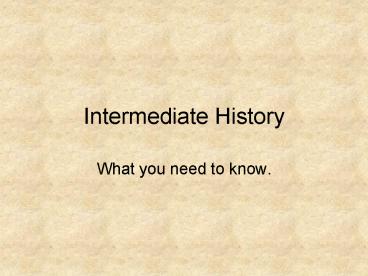Intermediate History PowerPoint PPT Presentation
Title: Intermediate History
1
Intermediate History
- What you need to know.
2
2. Wallace, Bruce and the Wars of Independence
1286 - 1328
- A study of the development of national identity
and consciousness through the Anglo-Scottish wars
of the thirteenth and fourteenth centuries,
illustrating the themes of authority, conflict
and identity - Scotland 1286 - 96 the succession problem
following the death of Alexander III the
Scottish response - Treaty of Birgham the death
of the Maid of Norway the Scottish appeal to
Edward I -the decision at Norham Bruce versus
Balliol, the Great Cause and Edwards choice
Edward as overlord of Scotland the Scottish
response the Anglo-French war and the
Franco-Scottish Treaty the subjugation of
Scotland. - William Wallace the reasons for and the progress
of his rebellion his victory at Stirling and its
effects on Scots and on Scotland the Battle of
Falkirk and the reasons for its failure. - Robert Bruce the ambitions of the Bruces Bruce
the patriot his conflict with and victory over
Scottish opponents his victory over the English
reasons for his success Declaration of Arbroath
- the triumph of the nation state in 1328.
3
2. The Cross and the Crescent The First Crusade
1096 - 1125
- A study of aspects of religious warfare in the
Middle Ages as seen in the events of the First
Crusade the themes illustrated are belief,
conflict and conquest - The meaning of Holy War, the reasons for the
calling of the First Crusade the religious,
military and economic reasons for taking the
cross the leaders and their motives. - Disputes and rivalries between Latins and Greeks
Peter the Hermit and the Peoples Crusade the
Princes Crusade and Alexius fears the taking
of the oaths. - Disputes and rivalries between crusaders,
especially Bohemond and Raymond the events
surrounding Edessa, Antioch and Maaara to
illustrate Christian strengths and weaknesses.
4
2. The Cross and the Crescent The First Crusade
1096 1125 (continued)
- Muslim divisions as a factor contributing to
Christian success Sunni and Shiite petty
rivalry openness to bribery as at Antioch and
Jerusalem. - The capture of Jerusalem and the massacre of the
inhabitants the securing of the Latin Kingdom
through kingship and feudalism, castle building,
the military orders and the Italian city-states
reasons for Christian success.
5
6. This Accursed Trade The British Slave Trade
and its Abolition 1770 - 1807
- A study of the nature of the British Atlantic
slave trade in the late eighteenth century,
changing attitudes towards it in Britain and the
pressures that led to its abolition, illustrating
the themes of rights, exploitation and culture - The organisation and nature of the slave trade
its effects on British ports, eg Liverpool,
Bristol its effects on African societies, eg
Ashanti, and on West Indian plantations. Slave
factories on the African coast the economics
and conditions of the Middle Passage. - Origins of the abolitionist movement and its
increased support outside and within Parliament.
Role of Wilberforce. Arguments of the
abolitionists Christian, humanitarian, economic.
Decision to concentrate on the slave trade. - Methods of the abolitionists meetings, evidence,
eg Clarkson first hand accounts by slavers, eg
Newton publicity, eg Wedgwood. Attitudes and
evidence of slaves and former slaves, eg Equiano.
Resistance to the trade by slaves.
6
7. From the Cradle to the Grave? Social Welfare
in Britain 1890s - 1951
- A study of the changing role of central
government in tackling the problem of poverty,
considering the themes of ideas and rights and
the development of new relationships between the
people of Britain and their government - The problem of poverty at the turn of the
century belief in self-help the voluntary
system the surveys of Booth and Rowntree
changing attitudes towards poverty and its
causes. - The Liberal reforms 1906 - 14 groups at risk -
the young, the old, the sick, the unemployed
reforms to help these groups - the Childrens
Charter, old age pensions, health and
unemployment insurance, labour exchanges
assessment of the success of their reforms. - The Labour government 1945 - 51 effects of
wartime experiences on attitudes to poverty,
especially the impact of bombing, rationing and
evacuation the Five Giants the National
Insurance and National Assistance the National
Health Service housing reform the idea of a
Welfare State assessment of the governments
achievement.

